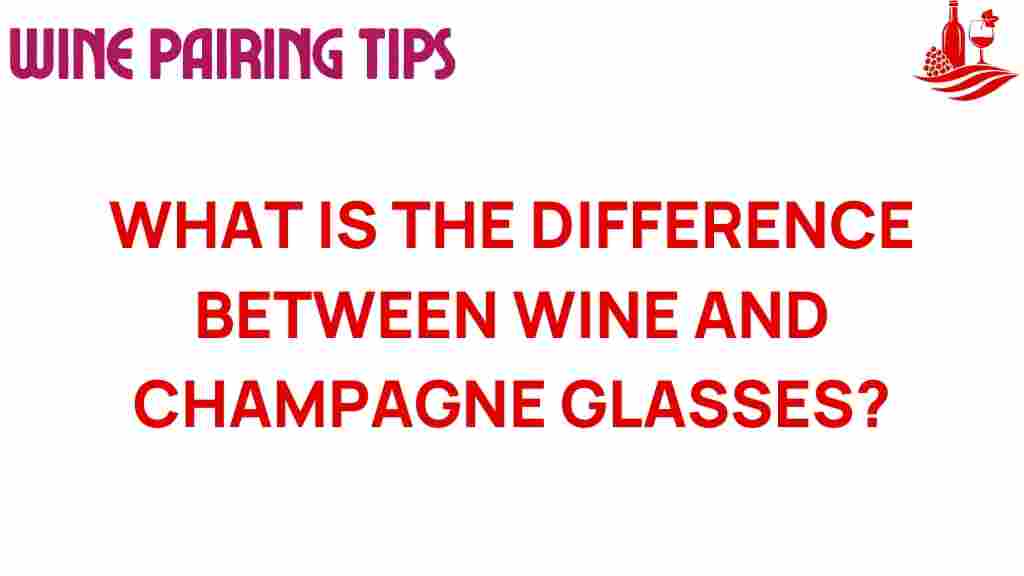Uncorking the Mystery: The Difference Between Wine Glasses and Champagne Glasses
When it comes to enjoying a fine drink, the glass you choose can significantly enhance your tasting experience. Whether you’re savoring a robust red wine or indulging in a sparkling bubbly, the right glass type is essential. In this article, we’ll explore the differences between wine glasses and champagne glasses, shedding light on how each contributes to drink presentation, flavor enhancement, and overall enjoyment. We will also discuss wine etiquette and provide serving tips to elevate your next gathering.
The Importance of Glass Types
Understanding the differences between wine glasses and champagne glasses can transform your drinking experience. Each glass is designed with a specific purpose in mind:
- Wine Glasses: Typically characterized by a wider bowl, wine glasses are crafted to enhance the aromas and flavors of various wines.
- Champagne Glasses: Designed to preserve the effervescence of sparkling wines, champagne glasses have a narrower shape to maintain bubbles and focus the aromas.
The design of glassware affects not only the presentation but also the sensory experience of the drink. The right glass can elevate a simple toast to an extraordinary celebration.
Types of Wine Glasses
Wine glasses come in several types, each tailored for specific varieties of wine:
- Red Wine Glasses: These glasses have a larger bowl to allow the wine to “breathe,” enhancing its flavor.
- White Wine Glasses: Slightly smaller than red wine glasses, these help maintain the cooler temperature of white wines.
- Rosé Glasses: Designed to balance the characteristics of rosé wines, they typically have a medium-sized bowl.
- Sparkling Wine Glasses: These are typically flute-shaped to keep bubbles intact longer.
Types of Champagne Glasses
Champagne glasses also come in various shapes, which influence the tasting experience:
- Flutes: Tall and narrow, flutes are designed to preserve bubbles and concentrate the aromas at the top.
- Coupe Glasses: With a wide, shallow bowl, coupes were popular in the past but are less effective at preserving carbonation.
- White Wine Glasses for Champagne: Some prefer to use white wine glasses for champagne, as they allow for more aroma exposure.
Choosing the right champagne glass can significantly affect how you perceive the bubbly. Flutes are often preferred for their visual appeal and practical advantages.
Enhancing the Tasting Experience
The right glass type not only enhances the presentation of your drink but also amplifies the tasting experience:
- Aroma: Wine glasses with a wider bowl allow for better aeration, letting the aromas escape and become more pronounced.
- Temperature: Different glass shapes can help maintain the desired temperature, crucial for both red and white wines.
- Bubbles: Champagne glasses are designed to keep the bubbles alive longer, maintaining the drink’s lively character.
By selecting the appropriate glass, you can ensure that you are experiencing the full spectrum of flavors and aromas present in your drink.
Wine Etiquette: Choosing the Right Glass
Wine etiquette plays a crucial role in how we enjoy our beverages. Here are some tips for selecting the right wine and champagne glasses:
- Know Your Wine: Familiarize yourself with the type of wine being served and choose a corresponding glass.
- Presentation Matters: A well-set table with the appropriate glassware enhances the overall dining experience.
- Keep It Clean: Ensure that your glasses are free from smudges or dust, as this can detract from the tasting experience.
Adhering to these etiquette tips will not only impress your guests but also enrich your own enjoyment of the wines and bubbly you serve.
Serving Tips for Wine and Champagne
Proper serving techniques can elevate your drinking experience. Here are some essential serving tips for both wine and champagne:
For Wine:
- Temperature: Serve red wines at room temperature (around 60-65°F) and white wines chilled (around 45-50°F).
- Pouring: Fill the glass about one-third full to allow for aeration and swirling.
- Swirling: Gently swirl the wine in the glass to release its aromas before tasting.
For Champagne:
- Chilling: Serve champagne well-chilled, ideally between 40-50°F.
- Pour Slowly: Pour champagne slowly down the side of the glass to minimize foam and preserve bubbles.
- Don’t Overfill: Fill the glass only halfway to allow for the release of bubbles and aromas.
By following these serving tips, you can ensure that both your wine and champagne are enjoyed to their fullest potential.
Troubleshooting Common Issues
Even with the best intentions, issues can arise when serving wine or champagne. Here are some common problems and solutions:
- Flat Champagne: If your champagne goes flat too quickly, consider using flutes to preserve the bubbles longer. Ensure the champagne is well-chilled before serving.
- Wine Too Warm: If your wine is served too warm, place the bottle in an ice bucket for a few minutes before serving.
- Smudged Glasses: If your glasses appear smudged, rinse them with warm water and dry them with a lint-free cloth before use.
By being aware of these common issues, you can ensure a better experience for yourself and your guests.
Conclusion
Understanding the differences between wine glasses and champagne glasses can significantly enhance your drinking experience. By choosing the right glass types, adhering to wine etiquette, and following proper serving techniques, you can elevate your tasting experience and impress your guests. Remember, the presentation of your drinks is as important as the quality of the beverages themselves.
So, the next time you uncork a bottle of your favorite wine or pop the cork on a bottle of bubbly, take a moment to consider the glass you are using. It can make all the difference in how you enjoy each sip. For more tips on wine and champagne, check out this informative guide.
Cheers to your next celebration, and may your wine and champagne always be served in style!
This article is in the category Tips and created by Wine Pairing Tips Team
